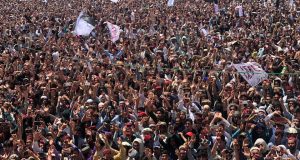Book Review: “The Real Pashtun Question: How To Control Religious Extremism, Misogyny And Pedophilia”? 
By: Dr. Farhat Taj
2017
Published By: Kautilya Books, New Delhi.
Contents: Acknowledgements, Preface, Seven Chapters, Endnotes, Annexes, Abbreviations, Glossary, References, Map.
pp.216.

Farhat Taj
Reviewed by Angelina Merisi.
Considering the enormous body of literature and scholarly works available concerning the Taliban movements and Pashtun socio-cultural and political society, in this volume, Dr. Farhat Taj offers a unique representation, realised through empirical research underpinned by an innate understanding of the people and region which is often grossly misunderstood, distorted and inadequately analysed. Hailing from Kohat in the Khyber Pakhtunkhwa lands of Northwest Pakistan, Taj’s authoritative account, lifts the rug on the taboo subject of pedophilia, moreover, dispelling many myths and misconceptions concerning the Taliban movements, their establishment and evolution. Taj cogently argues that Pashtun societal norms and traditions encompassed in ‘Pakhtunwali’ (Pashtun customary tribal code of honour), have been fundamentally hijacked and exploited to the extent that they imprison the inherently egocentric Pashtun male psyche. Taj demonstrates to what extent the Pakhtunwali has been systematically cultivated to form an interconnectedness between extremist religious ideology and Pashtun practices and cultural norms. Taj’s focus is primarily on the Pashtun ‘male’ character, since she states that females do not count in the ‘Pashtun socio-political universe, and are inherently subordinate to and the property of male relatives.’ There are reasons, she argues, as to why Pashtun society is held in an archaic state, one being that the Pashtun male character is ensnared by religious dependence – making him ‘vulnerable to exploitation by whosoever pretends to be fighting for Islam.’ This volume is the result of years of in-depth research and fieldwork at grass roots level carried out in locations infamously inaccessible to visitors, journalists and researchers alike. Persistent violence and decades of conflict has plagued the region as a result of Pakistan’s ‘strategic depth policy’ operated in part by its right hand and state lackey; the Intelligence services (ISI). International powers such as Saudi Arabia and the USA which in turn have contributed to harvesting unrest and violence in the region for strategic gains have fuelled tensions along with Pakistan’s national vested interests and strategic goals in Afghanistan and India.
In chapter one, titled: “Kurram: Resistance to Forced Sunnification;” Taj’s focus on Kurram as an example to convey the complexities and multi-faceted layers that make up the religious and socio-political dynamics of the region is a prudent choice. In relation to the seven agencies that make up the Federally Administered Tribal Areas (FATA), Kurram is divided into three constituents, inhabited by Shia and Sunni tribes along with a small non-Muslim population. Placed in historical context, Kurram was once part of the Kingdom of Afghanistan until the second Afghan war after which hundreds of Shia families migrated to Kurram to flee persecution, furthermore during the so-called ‘Afghan Jihad,’ a significant number of Sunni Afghan refugees settled in the Shia dominated Kurram agency which led to tensions and sectarian violence in the region. Although historically, Shia and Sunni tribes lived peacefully side by side, nonetheless, since the creation of Pakistan, and particularly since the ‘Afghan Jihad’ (1979-88), Taj tells us the state ‘wilfully ignores and even facilitates sectarian clashes in the region in order to fulfil its strategic objectives in Afghanistan.’ (14) Due to its geographical location, (Kurram’s capital city Parachinar is the shortest route to the Afghan capital, Kabul), the ISI specifically selected Kurram to carry out attacks on the Soviet forces in Afghanistan. With extensive funding from Saudi Arabia, the ‘Afghan Jihad’ mission, (which the predominant Shia population opposed), led to an operation under the guidance of General Zia-Ul-Haq, which transformed the demographics of the region through the violent, forced displacement of Shias for the strategic purpose of settling Sunni refugees in their place. Taj states that this demographic change in ousting the Shia ‘hurdle,’ laid the groundwork for procuring the ‘Strategic Depth Policy.’ Local disputes leading to extensive sectarian wars have plagued the region ever since. Taj recounts that the general consensus among citizens in the region consider the sectarian violence to be a direct consequence of the Strategic Depth Policy objective and for the establishment of safe havens for Taliban militants. Furthermore, the Pakistan army, ‘were forthright in their support for the Taliban’ during violent clashes, laying the groundwork for the ISI to procure safe passage for their deadly proxy outfit, the Haqqani Taliban network in the Shia-Cleansed Sunni dominated areas. Alarmingly, Taj asserts that the Haqqani family and its top leaders continue to live freely outside the FATA in places such as Peshawar and Rawalpindi (headquarters of the Pakistan army). Despite insufferable conditions and momentous hurdles, Taj stresses that the Shias of Kurram have demonstrated heroic resistance to the ‘forced Sunnification’ of Kurram, despite the ISI’s attempts to create safe passage for the Haqqani via Shia dominated areas.
In chapter two titled: “What is Taliban’s Ideology and How ‘Nationalists’ are they”? Taj recounts that Pashtun society under the watch of the Pakistan State and its ‘Jihadi policy has proven to be the laboratory where the culture of Islamic revival has been nurtured and let loose’ (59). It has been well documented that the Taliban are closely associated with the Pakistan Military establishment-the phenomenon categorically evolved in the wake of the so-called Afghan Jihad. In light of scholarly accounts which categorise the movements into three formations; ‘Old Taliban, Neo-Taliban and Pakistan Taliban,’ Taj clarifies that the first form of Islamic militants were selected and dispatched to Pakistan by the CIA and ISI to rid Afghanistan of the Soviets. The subsequent takeover of Kabul by the Mujahideen, who refused to adhere to Pakistan’s demands, didn’t go according to plan. Pakistan thereafter, targeted seminary students, who were used as replacements, trained and radicalised under the term, ‘Taliban’ as it is understood nowadays. The progression of the Pakistan Taliban then, is a succession of the original Afghan Mujahideen development designed as a means for the Pakistan State to protected itself against the escalation of insurgent (bad) Taliban. In 2007, various Taliban groups formed an umbrella insurrectionist assembly known as Tehrik-e-Taliban Pakistan (TTP) under the leadership of Baitullah Mahsud to carry out coordinated attacks within Pakistan. Taj states that Taliban ideology is a combination of Deobandi (Sunni) and Wahhabi Islamism spread by Saudi Arabia ‘who have spent over one hundred million dollars on the proliferation of Wahhabism in poorer Muslim countries.’ Taj argues that the Pakistan State has never used measures to extinguish violent Pashtun Islamists or modernise Pashtun society – the reason being that a modern society may not continue producing extremists that the state needs for its Jihadi undertakings. Taj stresses that Pashtun society is now a factory, continually churning out Jihadi militants to work for the Pakistan State. She goes on to make a very important point; that the fundamental Pashtun character of the Taliban is undeniable: “they construct constitutive narratives to normalise their values and ensure that people in the society internalise them through socialisation and order their lives accordingly.” In drawing comparisons between ordinary Pashtun people, their traditional societal norms, values and practices and the Taliban worldview, Taj concludes they are intrinsically interwoven, particularly regarding their shared pandemic egocentric, misogynistic mindset. The Taliban, according to Taj, have thus successfully exploited these socio-cultural characteristics to exercise influence.
Chapter Three is titled: “State, Human Rights and Social Change in Pashtun Socio-Cultural Universe.”
It is well documented that Pakistan’s human rights record is atrocious. Due to its prolonged pursuance of Strategic Depth Policy, Taj asserts that the Pakistan State is ensuring the preservation of oppressive conditions in Pashtun society so it can use Pashtuns for Jihadi projects. It is widely known that Pashtun culture is bleak and burdensome for women, ensnared by the characteristic, predominant misogynystic society. However, pedophilia, whereby young boys can be used for sexual pleasure by adult men is less documented and according to Taj, requires further research. Taj argues that pedophilia (bachabazi) is widespread in Pashtun society and silently accepted. Pedophilia in the form of child brides is also common. However, while Pashtun men are proud of the domination of their women, who are ‘the embodiment of a man’s honour and his property to dispose of as he pleases,’ Taj argues they are hypocritical about their pedophilia involving young boys, and pretend it doesn’t exist.’ Taj goes on to state that Tableeghi culture (Deobandi proselytising movement) is also promoting pedophilia, moreover, some tableeghi gatherings ‘are especially arranged for pedophilic purposes.’ Concerning the PTI and JI coalition partnership in the PTI led provincial government in Khyber Pakhtunkhwa, according to Taj, PTI chief, Imran Khan, is the Pakistani establishment’s most useful proxy to ‘normalise pro-Taliban discourses and narratives in mainstream Pakistan society.’ During the 2013 election campaign, PTI were ‘permitted’ to campaign freely, while over a course of time the Nationalist party, ANP have suffered the loss of 800 workers through Taliban attacks. Taj argues that the Taliban’s greatest gift to Imran Khan is the PTI government in Pakhtunkhwa. Moreover, media channels are state controlled and according to Taj, the media ran a campaign against ANP while glorifying PTI in order to influence the electorate. Besides ‘Jihad’ policy, she states another reason why ‘Islamism’ has become the acceptable norm in Pashtun society is because secular Pashtun Nationalism has never become extensively absorbed in the broader society. Despite the (Nationalist party) ANP’s political stance against militant Islamism, Taj states they have not fully snubbed deobandi extremism, for if they do, they may stand to lose popularity among Pashtuns. Furthermore their reliance on the state is precarious due to the state’s connivance in maintaining harsh, repressive aspects of Pashtun culture.
In Chapter 4, “The Humanitarian Crisis in FATA since 2007: A Sketch,” Taj focuses on the mammoth suffering, inflicted on the people of the FATA during conflict-driven displacement. While many National and International humanitarian organisations are providing assistance to displaced persons, other organisations have published reports on the crisis. In this chapter, Taj draws from her own experiences and observations while carrying out research in the FATA from 2007 – 2015. She discusses the countless Pakistan military operations which displaced millions and caused untold suffering among the people. Despite these ‘missions;’ to this day, the FATA remains plagued by security issues and sectarian violence, and most disturbingly, the area is still not cleared of Taliban militants. Taj paints a very grim picture of the sufferings of the displaced people such as little access to food, health facilities, housing, registration, and livelihoods. Women IDP’s are particularly vulnerable and suffer greatly due to ‘purdah’ demands, which in most cases condemn them to confinement in the home with no education or recreational facilities and little hope of contact with the outside world. Many suffer due to overcrowding and are subject to domestic abuse and violence. Mentally and physically challenged people, many of whom have zero access to health care or are even aware of the existence of government or private health care facilities, suffer greatly in this environment. The burial of deceased relatives is another enormous obstacle for these suffering people during displacement. Taj goes on to discuss the lingering issue of missing, kidnapped and abducted persons which causes untold suffering and heartbreak for families who are left not knowing if their loved ones are dead or alive.
Chapter 5 is titled: “The Other’s in Human Rights Discourses: A View from Norway and Pakistan.’ This chapter is inspired by a thesis of Professor Karima Bennoune, who emphasises that human rights lawyers and activists need to remain unbiased in their discourses and remain steadfast in advocating the universality of human rights without scrutiny based on ‘culture, tradition, past colonialism or claimed victim status.’ In the context of Pakistan, Taj stresses that human rights discourses need to take into account religious extremism, Taliban and terrorism. In her analysis, she discusses the concept of “good and bad” Taliban. ‘Bad’ Taliban, perceived as those fighting and killing inside Pakistan and ‘Good’ Taliban who work alongside the state, usually on the orders of the ISI, to carry out attacks inside Afghanistan and India: both are driven by the same ideology. Taj tells us that ‘bad’ Taliban who cannot be won over, are wiped out by the Pakistan military, while ‘good’ Taliban are given safe passage to relocate under various circumstances. Over the course of 1000 military operations carried out against the Taliban in the FATA, Taj tells us that not a single Taliban commander was either captured or killed, nor were networks eliminated. In relation to drone strikes, Taj argues that drone strikes are precise and conducted with the consent of the Pakistan army leadership (151). The US do not take into account the concept of ‘good and bad’ Taliban, hence the recent targeting of Taliban commanders killed by US drones on Pakistan soil. Taj states that when ‘bad’ Taliban are killed by strikes, the media are silent, yet when ‘good’ Taliban or as Taj asserts ‘on extremely rare occasions when civilians are killed – mainly women and children of the militants’ – there is mass outcry in Pakistan.
In Chapter 6, titled: “Frank Lesson,” Taj discusses her meeting and communications with Lesson who was a former British officer in North Waziristan (1946-7). In this chapter, she narrates some of her discussions and correspondence carried out with Lesson in 2007 via letters, emails and phone calls, in relation to his experiences and memories of his time spent in Waziristan. Taj also quotes from his book: “Frontier Legion,” (Lesson’s memoirs concerning the transfer of power from Britain to Pakistan in 1947). One of the reasons Taj approached Lesson, was to discuss Waziristan prior to the 1980s, during the time when the US, KSA and Pakistan used the area as ‘a base camp for Islamist militants fighting in Afghanistan.’ She asserts that she ‘decided to communicate the tragedy befalling Waziristan to the West through a documentary film titled: “Waziristan: A Culture Under Attack.” Her mission was to dispel the myth that people from Waziristan are predominantly Islamist fanatics who support the Taliban and moreover, to show that the people of Waziristan are also victims of terrorism and the Taliban.
In the final Chapter 7, titled: “Some Tributes,” Taj pays tribute to five deceased people whom she clearly cherished and admired – Iqbal Hussain, who was a Sunni Tribal leader of Upper Kurram, was target killed in the region; Laiq Hussain who was an FC soldier of the Kurram militia based in Waziristan, was captured and murdered by the Taliban; Fredrik Barth, the Norwegian anthropologist who passed away in 2016; Benazir Bhutto, who was assassinated in 2007; and finally Bashir Bilour an ANP legislator who was assassinated in a Taliban terror attack in 2012.
I would recommend and urge that scholars, academics and anyone with an interest in gaining a true understanding of the Taliban movements and Pashtun culture and society in general, to read this book. It is an authentic account of the socio-political, cultural and religious landscape of the region, delivered by a unique and courageous voice.
For more information about Dr. Farhat Taj, see: http//:www.farhattaj.org

Angelina Merisi
Angelina Merisi hails from Ireland. She is part of the Pashtuns Times’ Team. She has a BA degree in History of Art, MA in Study of Religions. She won a PhD scholarship for her research on Pashtun Culture and Society. She is currently on sabbatical. In the meantime, she continues writing and researching on Pashtun culture and society.
 Pashtun Times Latest News
Pashtun Times Latest News



